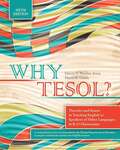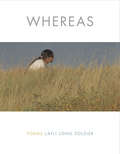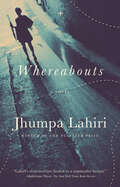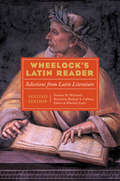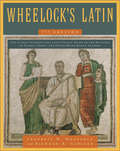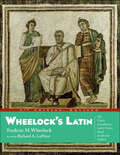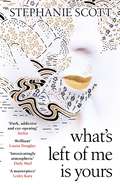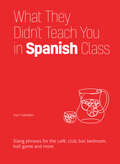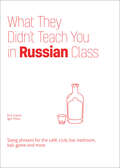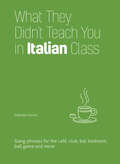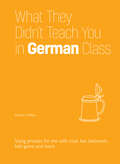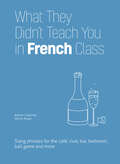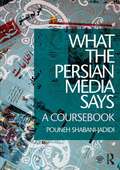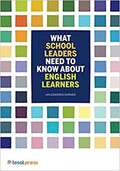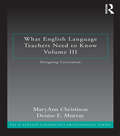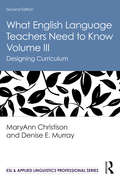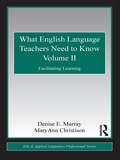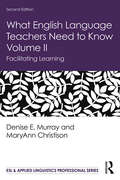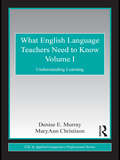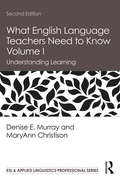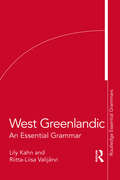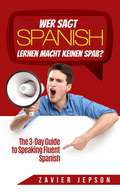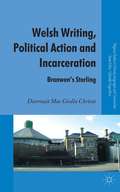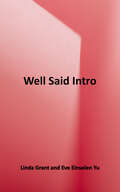- Table View
- List View
Why Tesol? Theories And Issues In Teaching English To Speakers Of Other Languages In K-12 Classrooms
by Eileen Ariza Maria Coady BedardWhy TESOL? Fifth Edition, provides classroom and preservice teachers with a knowledge base to effectively teach in culturally and linguistically diverse classrooms in today’s global environment. It provides in depth theoretical background, legal information, and application for teachers to address the needs of English learners. Why TESOL? is written so teachers from various backgrounds and experiences can readily apply ESOL concepts to their individual mainstream classroom settings. FEATURED TOPICS Describes the legal rights of English language learners (ELs); provides an historical overview of laws (e.g., ESSA) in the United States that affect the education of EL students, and provides a clear classification of English as a second/new language (ESL/ENL) programs available in the United States. Helps readers understand the complexities of acquiring an additional language by providing a basic grounding in the core areas of linguistics and other related areas, such as non-verbal communication, dialectal variation, English language use, development, translanguaging, and literacy. Discusses first and second/new language theories and models, including processes and non-linguistic factors that affect second or additional language acquisition. Includes national statistics that illuminate the global nature of American society in the twenty-first century. Includes classroom experiences of new and experienced teachers, and provides examples adapting teaching strategies to better measure the academic success of second language learners in mainstream classrooms. Includes new chapters on literacy development, and family engagement for EL students. INCLUDES learning objectives for each chapter, discussion and reflection questions, and activities. Each chapter also provides web resources and links for extended learning.
WHEREAS: Poems
by Layli Long SoldierThe astonishing, powerful debut by the winner of a 2016 Whiting Writers' AwardWHEREAS her birth signaled the responsibility as mother to teach what it is to be Lakota therein the question: What did I know about being Lakota? Signaled panic, blood rush my embarrassment. What did I know of our language but pieces? Would I teach her to be pieces? Until a friend comforted, Don’t worry, you and your daughter will learn together. Today she stood sunlight on her shoulders lean and straight to share a song in Diné, her father’s language. To sing she motions simultaneously with her hands; I watch her be in multiple musics.—from “WHEREAS Statements”WHEREAS confronts the coercive language of the United States government in its responses, treaties, and apologies to Native American peoples and tribes, and reflects that language in its officiousness and duplicity back on its perpetrators. Through a virtuosic array of short lyrics, prose poems, longer narrative sequences, resolutions, and disclaimers, Layli Long Soldier has created a brilliantly innovative text to examine histories, landscapes, her own writing, and her predicament inside national affiliations. “I am,” she writes, “a citizen of the United States and an enrolled member of the Oglala Sioux Tribe, meaning I am a citizen of the Oglala Lakota Nation—and in this dual citizenship I must work, I must eat, I must art, I must mother, I must friend, I must listen, I must observe, constantly I must live.” This strident, plaintive book introduces a major new voice in contemporary literature.
Whereabouts: A Novel (Vintage Contemporaries Ser.)
by Jhumpa LahiriA marvelous new novel from the Pulitzer Prize-winning author of The Lowland and Interpreter of Maladies--her first in nearly a decade. <P><P>Exuberance and dread, attachment and estrangement: in this novel, Jhumpa Lahiri stretches her themes to the limit. The woman at the centre wavers between stasis and movement, between the need to belong and the refusal to form lasting ties. The city she calls home, an engaging backdrop to her days, acts as a confidant: the sidewalks around her house, parks, bridges, piazzas, streets, stores, coffee bars. We follow her to the pool she frequents and to the train station that sometimes leads her to her mother, mired in a desperate solitude after her father's untimely death. In addition to colleagues at work, where she never quite feels at ease, she has girl friends, guy friends, and "him," a shadow who both consoles and unsettles her. But in the arc of a year, as one season gives way to the next, transformation awaits. One day at the sea, both overwhelmed and replenished by the sun's vital heat, her perspective will change. <P><P>This is Jhumpa Lahiri's first novel written in Italian. It brims with the impulse to cross barriers. By grafting herself onto a new literary language, Lahiri has pushed herself to a new level of artistic achievement. <P><P><b>A New York Times Best Seller</b>
Wheelock's Latin Reader, 2e
by Richard A. LafleurOriginally intended by Professor Frederic M. Wheelock as a sequel to Wheelock's Latin, his classic introductory Latin textbook, Wheelock's Latin Reader, newly revised and updated by Richard A. LaFleur, is the ideal text for any intermediate-level Latin course. You'll find a rich selection of of prose and poetry from a wide range of classical authors, as well as briefer passages from medieval and Late Latin writers, each presented in the Latin in which it was originally written. Useful features include extensive notes; a complete Latin-English vocabulary; maps of ancient Italy, Greece, and the Roman Empire; and numerous photographs illustrating aspects of classical culture, mythology, and history featured in the readings.
Wheelock's Latin 7th Edition
by Richard A. LafleurFor nearly sixty years, Wheelock's Latin has remained the opitmus liber of beginning Latin textbooks. When Professor Frederic M. Wheelock's Latin first appeared in 1956, the reviews extolled its thoroughness, organization, and conciseness; one reviewer predicted that the book "might well become the standard text" for introducing students to elementary Latin. Now, nearly six decades later, that prediction has certainly proved accurate.This new edition of Wheelock's Latin has all of the features, many of them improved and expanded, that have made it the bestselling single-volume beginning Latin textbook: 40 chapters with grammatical explanations and readings drawn from the works of Rome's major prose and verse writers; Self-tutorial exercises, each with an answer key, for independent study; An extensive English-Latin/Latin-English vocabulary section; A rich selection of original Latin readings--unlike other Latin textbooks, which contain primarily made-up texts; Etymological aids, maps, and dozens of images illustrating aspects of the classical culture and mythology presented in the chapter readings. Also included are expanded notes on the literary passages, comments on vocabulary, and translation tips; new comprehension and discussion questions; and new authentic classical Latin readings, including Roman graffiti, in every chapter. <P><P><i>Advisory: Bookshare has learned that this book offers only partial accessibility. We have kept it in the collection because it is useful for some of our members. To explore further access options with us, please contact us through the Book Quality link. Benetech is actively working on projects to improve accessibility issues such as these.</i>
Wheelock's Latin: The Classic Introductory Latin Course, Based on Ancient Authors
by Frederic M. WheelockThe classic, single–volume introductory Latin textbook, introduced in 1956 and still the bestselling and most highly regarded textbook of its kind. Wheelock's Latin, sixth edition, revised, has all the features that have made it the best–selling single–volume beginning Latin textbook, many of them revised and expanded: o 40 chapters with grammatical explanations and readings based on ancient Roman authors o Self–tutorial exercises with an answer key for independent study o An extensive English–Latin/ Latin–English vocabulary section o A rich selection of original Latin readings –– unlike other textbooks which contain primarily made–up Latin texts o Etymological aids Also includes maps of the Mediterranean, Italy and the Aegean area, as well as numerous photographs illustrating aspects of classical culture, mythology, and historical and literary figures presented in the chapter readings. o The leading self–tutorial Latin program. Also great for college and accelerated high school courses. o Wheelock's Latin is the top–selling Latin reference in the US. o Interest and enrolments in Latin have been steadily rising in the U.S. for the past 20 years. One–half million people are currently enrolled in Latin classes, and at least 10,000 teachers, professors and graduate assistants are teaching the language in America.
What's Left of Me is Yours
by Stephanie ScottA BOOK OF THE YEAR FOR THE DAILY MAIL AND WOMAN AND HOMEA New York Times 'Editor's Pick'One of the Observer's Ten Best Debut Novelists of 2020Shortlisted for the Author's Club First Novel AwardLonglisted for the Jhalak PrizeLonglisted for the CWA John Creasy New Blood Dagger'Enrapturing... This richly imagined novel considers the many permutations of love and what we are capable of doing in its name' New York Times'A brilliant debut' Louise Doughty, author of Apple Tree Yard'You'll have the heart rate of an Olympic hurdler' Sunday Express'I read it with my heart in my throat' Sara Collins, author of The Confessions of Frannie Langton 'An exquisitely crafted masterpiece you'll be pressing into the hands of others' Woman & Home 'An intoxicatingly atmospheric mystery' Daily Mail'Dark, addictive and eye-opening, this is a brilliant debut' StylistA gripping debut set in modern-day Tokyo and inspired by a true crime, What's Left of Me Is Yours follows a young woman's search for the truth about her mother's life - and her murder.In Japan, a covert industry has grown up around the wakaresaseya (literally "breaker-upper"), a person hired by one spouse to seduce the other in order to gain the advantage in divorce proceedings.When Sato hires Kaitaro, a wakaresaseya agent, to have an affair with his wife, Rina, he assumes it will be an easy case. But Sato has never truly understood Rina or her desires and Kaitaro's job is to do exactly that - until he does it too well.While Rina remains ignorant of the circumstances that brought them together, she and Kaitaro fall in a desperate, singular love, setting in motion a series of violent acts that will forever haunt her daughter Sumiko's life.Told from alternating points of view and across the breathtaking landscapes of Japan, What's Left of Me Is Yours explores the thorny psychological and moral grounds of the actions we take in the name of love, asking where we draw the line between passion and possession.
What We Talk About When We Talk About Love (Mandarin Edition)
by Raymond CarverIn his second collection of stories, as in his first, Carver's characters are peripheral people--people without education, insight or prospects, people too unimaginative to even give up. Carver celebrates these men and women. 当我们谈论爱情时我们在谈论什么 是雷蒙德·卡佛优秀的短篇小说集 由17篇短篇小说组成 讲述了如餐馆女招待,锯木厂工人,修车工,推销员和汽车旅馆管理员等社会底层的体力劳动者的生活 这些普通人有着普通人的愿望 做着再普通不过的事情 但他们发现自己在为生存而挣扎 无法达到在常人看来并不远大的人生目标 他们的生活中充满了窘困和不如意 婚姻破裂 失业 酗酒 破产 卡佛用"极简"的遣词,冷静疏离的叙事 表现了现代社会中人的边缘性以及现代人脆弱的自我意识 本书的出版 为美国短篇小说写作注入了新的生命 并为卡佛赢得了"美国的契诃夫"的称号 使他成为美国继海明威之后受到模仿最多的作家
What They Didn't Teach You in Spanish Class: Slang Phrases for the Cafe, Club, Bar, Bedroom, Ball Game and More (Dirty Everyday Slang)
by Juan CaballeroChilling with an ice-cold cerveza at a beach bar...Dancing at CDMX&’s hottest salsa club...Screaming your head off at the Copa América...Drop the textbook formality and chat with the locals in Latin America&’s everyday language.• What&’s up? ¿Qué tal?• What a hottie! ¡Que cuerazo!• Let&’s pound these shots. Tráguemonos estos traguitos.• That ref sucks. Es una mierda ese árbitro/a.• I&’m craving all-you-can-eat tacos. Me antoja un poco de taquiza libre.• Do you wanna hook up? ¿Quieres ligar?
What They Didn't Teach You in Russian Class: Slang Phrases for the Cafe, Club, Bar, Bedroom, Ball Game and More (Dirty Everyday Slang)
by Igor Fisun Erin CoyneGrubbing on pierogies at a a Russian deli...Pounding vodka shots at Moscow&’s hottest dance club...Cheering for the local hockey team at the stadium...Drop the textbook formality and chat with the locals in Russia&’s everyday language.• What&’s up? Как дела?• He&’s/She&’s a hottie. Он/Она красавчик/красотка.• Let&’s go get wasted. Пойдём побухать.• Goooooooaaaaaaal! Гоооооооол!• This is crappy vodka. Эта водка хреновая.• Let&’s have a quickie. Давай по быстрому.
What They Didn't Teach You in Italian Class: Slang Phrases for the Cafe, Club, Bar, Bedroom, Ball Game and More (Dirty Everyday Slang)
by Gabrielle EuvinoSipping espresso at a sidewalk café...Toasting a pint of birra in the piazza...Cheering for Azzurri at lo Stadio Olimpico...Drop the textbook formality and chat with the locals in Italy&’s everyday language.• What&’s up? Che c&’è?• I&’m so plastered. Sono demolito/a.• Do you wanna cuddle? Vuoi coccolarci?• Nice body! Che corpo!• I&’m friggin&’ starving. Ho una fame da morti.• Hey ref, you&’re a moron! Arbitro cretino!
What They Didn't Teach You in German Class: Slang Phrases for the Cafe, Club, Bar, Bedroom, Ball Game and More (Dirty Everyday Slang)
by Daniel ChaffeyDrinking a Hefeweizen at a Biergarten...Dancing at Berlin&’s hottest club...Cheering for the local soccer team at the Stadion...Drop the textbook formality and chat with the locals in Germany&’s everyday language.• What&’s up? Wie geht&’s?• He/She is a real hottie. Er/Sie ist eine ganz heiße Nummer.• What&’s on tap? Was gibt&’s vom Fass?• I ordered the Currywurst. Ich bin den Currywurst.• Do you wanna cuddle? Willst Du kuscheln?• Gooooooal! Toooooor!
What They Didn't Teach You in French Class: Slang Phrases for the Cafe, Club, Bar, Bedroom, Ball Game and More
by Henry Rowe Adrien ClautrierSipping a café au lait at a sidewalk bistro...Getting down at Paris&’s hottest club...Cheering on Les Bleus at the stadium...Drop the textbook formality and chat with the locals in France&’s everyday language.• What&’s up? Ça va?• She&’s totally hot. Elle est bandante.• This party is lit! Cette bringue est enflammée!• That brie smells funky. Ce brie sent putain de drôle.• Wanna French kiss? On se roule une pelle?• That ref is a moron. L&’arbitre est un abruti.
What the Persian Media says: A Coursebook
by Pouneh Shabani-JadidiWhat the Persian Media Says: A Coursebook is a comprehensive and stimulating course for intermediate to advanced students of Persian. Presenting many exercises based on authentic Persian newspaper texts, the course thoroughly introduces students to the language of the news in Iran. Real cultural content is featured throughout and there is a strong focus on enabling students to gain familiarity with day-to-day modern Persian discourse. Features include: A wide range of interesting and challenging exercises presented throughout, including activities designed to both test students’ knowledge in a classroom setting and to search online for further Persian news resources Usage of authentic texts from the Iranian media, written for native speakers, with sources including Ettel?’?t, Keyh?n, Sharq, E’tem?d, Ir?n, and Mardoms?l?ri Coverage of topics highly relevant to modern day Persian society, including the Arts, divorce, violence, problems of youth, unemployment, politics and economic issues, enabling cultural engagement and knowledge of complex expressions and idioms used in the media A comprehensive bilingual glossary of journalistic and non-journalistic terminology used in the newspaper texts, provided at the back of the book for easy access All the newspaper texts and their corresponding audio files available for free download at http://routledgetextbooks.com/textbooks/9781138825567/ What the Persian Media Says combines modern and more traditional techniques of language teaching. With all the newspaper texts and their corresponding audio files available for free on the Routledge website, students can read the texts in digital form and listen to the audio while working on exercises in the book, enabling full and exciting engagement with the course materials. Written by an experienced instructor, this will be an invaluable resource for intermediate to advanced undergraduate and postgraduate students of Persian. It can also be used by self-learners and by instructors and students on intensive courses and summer language programs.
What School Leaders Need to Know About English Learners
by Jan DormerSchool leaders have the unique opportunity and responsibility to play a crucial role in creating a culture of high expectations and an environment of support so that English language learners can succeed and continue to enrich the fabric of our country. <p><p> What School Leaders Need to Know About English Learners offers school leaders the foundation, the ideas, and the strategies to not only improve outcomes for English language learners, but to create rich multicultural and multilingual school environments which benefit all students. This book equips school leaders with effective, research-based strategies and best practices to help both ESOL and content-area teachers succeed in their roles. Includes a Professional Development Guide and a rich array of "Grab and Go" online resources. Copublished with National Association of Secondary School Principals (NASSP).
What English Language Teachers Need to Know Volume III: Designing Curriculum
by MaryAnn Christison Denise E. MurrayWhat English Teachers Need to Know, a set of companion texts designed for pre-service teachers and teachers new to the field of ELT, addresses the key question: What do English language teachers need to know and be able to do in order for their students to learn English? These texts work for teachers across different contexts (countries where English is the dominant language, one of the official languages, or taught as a foreign language); different levels (elementary/primary, secondary, college or university, or adult education); and different learning purposes (general English, workplace English, English for academic purposes, or English for specific purposes). Volume I, on understanding learning, provides the background information that teachers need to know and be able to use in their classroom. Volume II, on facilitating learning, covers the three main facets of teaching: planning, instructing, and assessing. Volume III, on designing curriculum, covers the contexts for, processes in, and types of ELT curricula—linguistic based, content-based, learner-centered, and learning-centered. Throughout the three volumes, the focus is on outcomes, that is, student learning. Features • Situated in current research in the field of English language teaching and other disciplines that inform it • Sample data, including classroom vignettes • Three kinds of activities/tasks: Reflect, Explore, and Expand
What English Language Teachers Need to Know Volume III: Designing Curriculum (ESL & Applied Linguistics Professional Series)
by MaryAnn Christison Denise E. MurrayDesigned for pre-service and novice teachers in ELT, What English Language Teachers Need to Know Volumes I, II, and III are companion textbooks organized around the key question: What do teachers need to know and be able to do in order to help their students to learn English?Thoroughly revised and updated, the second edition of Volume III explores the contexts for ELT curricula; explains key processes in curriculum design; and sets out approaches to curricula that are linguistic-based, content-based, learner centered, and learning centered. Organized around the three pillars of teaching—planning, instructing, and assessing—chapters in the second edition are updated to include current research and theory to meet the needs of today’s teachers, and feature new or revised vignettes and activities. New chapters help teachers understand both the technological and multilingual approaches that learners need to succeed today. The comprehensive texts of this series are suitable resources for teachers across different contexts—where English is the dominant language, an official language, or a foreign language; for different levels—elementary/primary, secondary, university, or adult education; and for different learning purposes—general English, workplace English, English for academic purposes, or English for specific purposes.
What English Language Teachers Need to Know Volume II: Facilitating Learning
by Denise E. Murray MaryAnn ChristisonDesigned for pre-service teachers and teachers new to the field of ELT, Volume II and its companion are companion textbook, Volume I, are volumes organized around the key question: What do teachers need to know and be able to do in order for their students to learn English? Volume I covers the characteristics of the context in which teachers work, how English works and how it is learned, and the teacher’s role in the larger professional sphere of English language education. Volume II covers the three main facets of teaching: planning, instructing, and assessing. The focus throughout is on outcomes, that is, student learning. The texts work for teachers across different contexts (countries where English is the dominant language, one of the official languages, or taught as a foreign language); different levels (elementary/primary, secondary, college or university, or adult education), and different learning purposes (general English, workplace English, English for academic purposes, or English for specific purposes).
What English Language Teachers Need to Know Volume II: Facilitating Learning (ESL & Applied Linguistics Professional Series)
by Denise E. Murray MaryAnn ChristisonDesigned for pre-service teachers and teachers new to the field of ELT, Volume II of the What English Language Teachers Need to Know set covers the three main facets of teaching: planning, instructing, and assessing. Updated with new research throughout, the focus throughout is on outcomes, that is, student learning. The texts work for teachers across different contexts; different levels, and different learning purposes. The Second Edition has expanded to address corpus-based data, new technologies, and a wider range of contexts.
What English Language Teachers Need to Know Volume I: Understanding Learning
by Denise E. Murray MaryAnn ChristisonDesigned for pre-service teachers and teachers new to the field of ELT, What English Teachers Need to Know I and II are companion textbooks organized around the key question: What do teachers need to know and be able to do in order for their students to learn English? The focus throughout is on outcomes, that is, student learning. Volume I, on understanding learning, provides the background information that teachers need to know and be able to use in their classroom: the characteristics of the context in which they work how English works and how it is learned their role in the larger professional sphere of English language education Volume II, on facilitating learning, covers the three main facets of teaching: planning instructing assessing The texts work for teachers across different contexts (countries where English is the dominant language, one of the official languages, or taught as a foreign language); different levels (elementary/primary, secondary, college or university, or adult education), and different learning purposes (general English, workplace English, English for academic purposes, or English for specific purposes).
What English Language Teachers Need to Know Volume I: Understanding Learning (ESL & Applied Linguistics Professional Series)
by Denise E. Murray MaryAnn ChristisonDesigned for pre-service teachers and teachers new to the field of ELT, What English Teachers Need to Know Volumes I, II, and III are companion textbooks organized around the key question: What do teachers need to know and be able to do in order for their students to learn English? In the Second Edition of Volume I, Murray and Christison return to this essential question and call attention to emerging trends and challenges affecting the contemporary classroom. Addressing new skills and strategies that EFL teachers require to meet the needs of their shifting student populations who are impacted by changing demographics, digital environments, and globalization, this book, which is grounded in current research, offers a strong emphasis on practical applications for classroom teaching. This updated and expanded Second Edition features: a new chapter on technology in TESOL new and updated classroom examples throughout discussions of how teachers can prepare for contemporary challenges, such as population mobility and globalization The comprehensive texts work for teachers across different contexts—where English is the dominant language, an official language, or a foreign language; for different levels—elementary/primary, secondary, university, or adult education; and for different learning purposes—general English, workplace English, English for academic purposes, or English for specific purposes.
West Greenlandic: An Essential Grammar (Routledge Essential Grammars)
by Lily Kahn Riitta-Liisa ValijärviThis grammar provides a clear and comprehensive overview of contemporary West Greenlandic. It follows a systematic order of topics beginning with the alphabet and phonology, continuing with nominal and verbal morphology and syntax, and concluding with more advanced topics such as complex sentences and word formation. Grammatical points are illustrated with authentic examples reflecting current life in Greenland. Grammatical terminology is explained fully for the benefit of readers without a background in linguistics. Features include: Full grammatical breakdowns of all examples for ease of identifying individual components of complex words. A detailed contents list and index for easy access to information. An alphabetical list of the most commonly used West Greenlandic suffixes. A glossary of grammatical abbreviations used in the volume. The book is suitable for a wide range of users, including independent and classroom-based learners of West Greenlandic, as well as linguists and anyone with an interest in Greenland’s official language.
Wer sagt Spanisch lernen macht keinen Spaß?
by Zavier JepsonSuchen Sie nach einem Weg Ihr Spanisch zu verbessern und wollen Sie es so schnell wie möglich für Ihren nächsten Urlaub oder ihr nächstes Familientreffen lernen? Dann haben Sie genau das richitge Buch gefunden. Mit "Wer sagt Spanisch lernen macht keinen Spaß?" lernen Sie die Sprache in kürzester Zeit fließend. Mit den besonderen Lerntechniken können Sie die Sprache sogar innerhalb von drei Tagen lernen!
Welsh Writing, Political Action and Incarceration: Branwen’s Starling (Palgrave Studies in Minority Languages and Communities)
by Diarmait Mac Giolla ChríostWelsh Writing, Political Action and Incarceration examines the prison literature of certain iconic Welsh authors whose political lives and creative writings are linked to ideas about Wales and the Welsh language, the nature of political activism, and the function of incarceration.
Well Said Intro (Well Said, New Edition Series)
by Linda Grant Eve Einselen YuThe Well Said series is designed to improve the pronunciation and communication skills of beginner to advanced students from all language backgrounds. It offers a clear course plan covering the essential areas of pronunciation, including stress, rhythm, and intonation--features that research shows help students the most. Additionally, there are over fifty pages of supplemental activities focusing on consonant and vowel sounds. The Intro level of Well Said is a slower-paced course that introduces the most important pronunciation features at the beginning to low-intermediate level. A free Website for teachers and students includes the full audio program.
